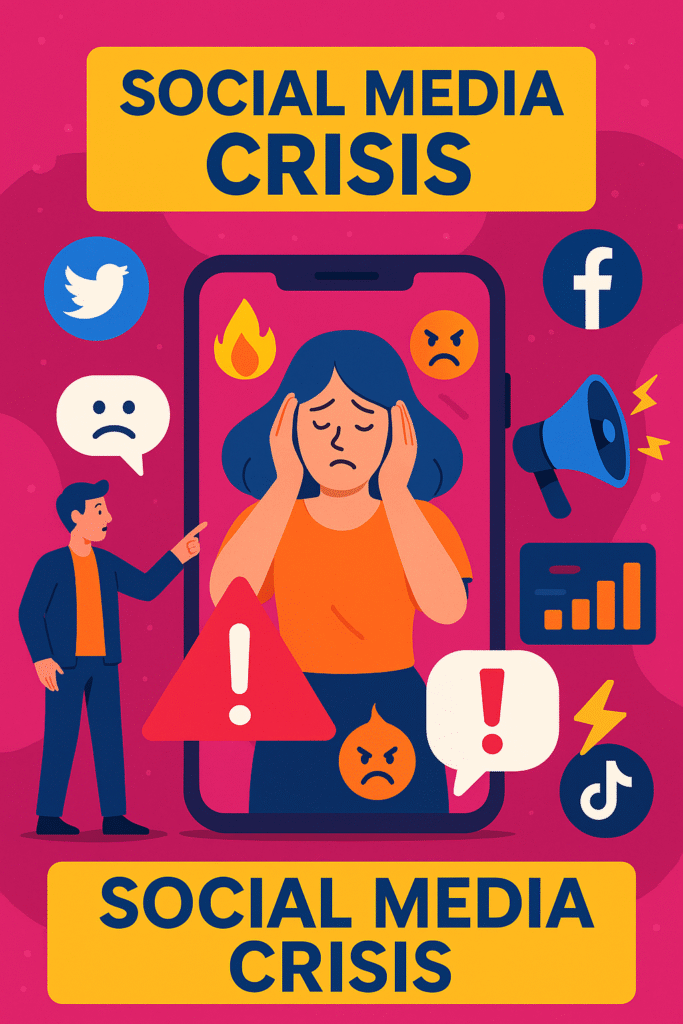Table of Contents
Social media crisis can strike any brand at any moment, turning a quiet Tuesday into a public relations nightmare. One negative post, customer complaint, or viral mishap can spiral into thousands of angry comments, damaged reputation, and lost customers within hours. The speed and reach of social platforms mean that crisis management has become a critical skill for businesses of all sizes.
Modern consumers expect instant responses and transparent communication when issues arise. Companies that fail to address problems quickly often find themselves facing amplified backlash. The stakes are higher than ever, with 87% of consumers saying they would stop buying from a brand after a social media crisis if handled poorly.
This article explores proven strategies and tools that help businesses navigate social media storms effectively. From monitoring systems that catch problems early to communication tactics that rebuild trust, these approaches can mean the difference between a minor setback and a major reputation disaster.
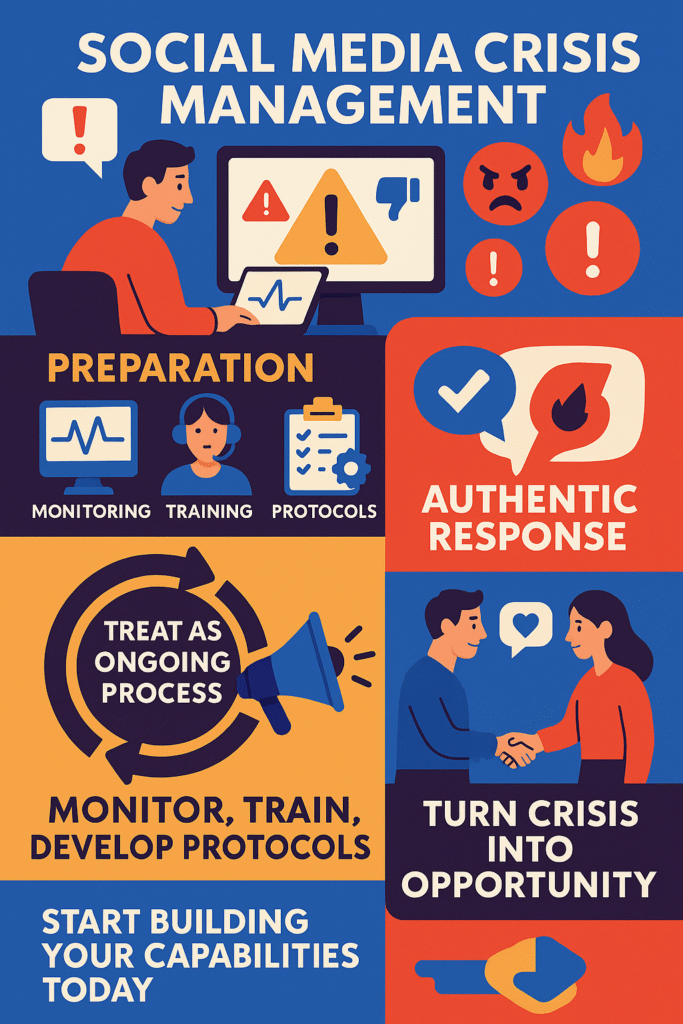
Understanding Social Media Crisis
A social media crisis occurs when negative content about a brand spreads rapidly across social platforms, potentially damaging reputation and business operations. Unlike traditional PR crises, social media incidents can escalate within minutes rather than hours or days.
Common triggers include customer service failures, product defects, controversial statements, data breaches, or employee misconduct. The viral nature of social content means that even minor complaints can snowball into major issues if not addressed promptly.
The interconnected nature of social platforms amplifies crisis situations. A complaint on Twitter can quickly spread to Facebook, Instagram, and TikTok, reaching millions of users before companies can respond. This rapid spread requires businesses to have response systems ready at all times.
Modern crisis management must account for the 24/7 nature of social media. Problems don’t wait for business hours, and delayed responses often make situations worse. Companies need monitoring systems and response protocols that work around the clock.
Real-World Social Media Crisis Examples
United Airlines Flight Incident
In 2017, United Airlines faced backlash after a passenger was forcibly removed from an overbooked flight. The incident was widely shared on social media, leading to a significant drop in the airline’s stock price. The company’s initial response was criticized for being slow and lacking empathy.
Pepsi’s Kendall Jenner Ad
In 2017, Pepsi released an advertisement featuring Kendall Jenner that was accused of trivializing social justice movements. The backlash was immediate, and Pepsi quickly pulled the ad and issued an apology.
KFC Chicken Shortage Crisis
KFC faced a different type of crisis in 2018 when they ran out of chicken in the UK. Instead of hiding from the problem, they launched a clever campaign acknowledging the issue with humor. Their “FCK” advertisement turned potential disaster into positive engagement, showing how authentic communication can work during difficult times.
Starbucks Racial Bias Incident
Starbucks experienced a major crisis in 2018 when two Black men were arrested at a Philadelphia location. The incident sparked widespread protests and calls for boycotts. The company responded by closing 8,000 stores for racial bias training, demonstrating how decisive action can help address serious social issues.
These examples show that crisis management success depends more on response quality than the original problem. Companies that acknowledge mistakes, take responsibility, and implement concrete changes often emerge stronger than before.
Building Your Crisis Management Strategy
Effective crisis management starts with preparation before problems arise. Companies need clear protocols, designated response teams, and pre-approved messaging templates. The goal is to reduce response time and ensure consistent communication across all channels.
Creating Response Teams and Protocols
Response teams should include representatives from social media, public relations, legal, and executive leadership. Each member needs defined roles and authority levels for different types of crises. This prevents confusion and delays when time is critical.
Developing Pre-Approved Messaging
Pre-approved messaging templates help maintain consistency during high-pressure situations. These templates should cover common scenarios like product recalls, service outages, or negative reviews. Having frameworks ready allows teams to customize responses quickly without starting from scratch.
Regular Training
Regular training and simulation exercises keep teams prepared for real situations. Practice scenarios help identify weaknesses in response plans and improve coordination between departments. The more realistic the training, the better teams perform during actual crises.
Essential Tools to Manage Social Media Crisis
Social Media Monitoring Tools
Hootsuite provides comprehensive social media monitoring capabilities that help catch potential crises early. The platform tracks mentions, hashtags, and keywords across multiple social networks simultaneously. Real-time alerts notify teams when unusual activity or negative sentiment spikes occur.
Sprout Social offers advanced sentiment analysis that goes beyond basic mention tracking. The tool analyzes the emotional tone of conversations, helping teams identify when negative sentiment might escalate into larger problems. This early warning system allows for proactive intervention.
Analytics Tools
Brandwatch specializes in social listening with powerful analytics features. The platform can track conversations across millions of online sources, providing detailed insights into how crises develop and spread. Advanced filtering options help teams focus on the most important conversations.
Crisis Management Software
Crisis management software, such as Everbridge, provides organizations with a platform to manage communication during a crisis. These tools can streamline the response process and ensure that all team members are on the same page.
Communication Platforms
Platforms like Slack or Microsoft Teams can facilitate internal communication during a crisis. These tools allow teams to collaborate and share information quickly.
Content Creation Tools
Tools like Canva and Adobe Spark can help create visual content for crisis communication. Engaging visuals can enhance messages and make them more shareable.
Free Monitoring Solutions
Google Alerts remains a valuable free tool for basic monitoring. While not as sophisticated as paid platforms, it provides alerts when specific keywords or brand mentions appear in news articles or blog posts. This tool works well for smaller businesses with limited budgets.
Crisis Communication Tactics
Speed matters more than perfection in crisis communication. Acknowledging problems quickly, even without complete solutions, shows customers that the company is aware and taking action. A simple “we’re investigating this issue” message can buy time while teams develop comprehensive responses.
Transparency builds trust during difficult situations. Companies should share what they know, what they’re doing to fix problems, and realistic timelines for resolution. Hiding information or making promises that can’t be kept usually makes situations worse.
Empathy should guide all crisis communications. Acknowledging how problems affect customers shows that companies care about more than just business metrics. Personal language and genuine concern resonate better than corporate jargon during emotional situations.
Consistency across all channels prevents mixed messages that can confuse customers. The same core message should appear on Twitter, Facebook, Instagram, and company websites. Different platforms may require different formats, but the essential information should remain the same.
Damage Control and Recovery Strategies
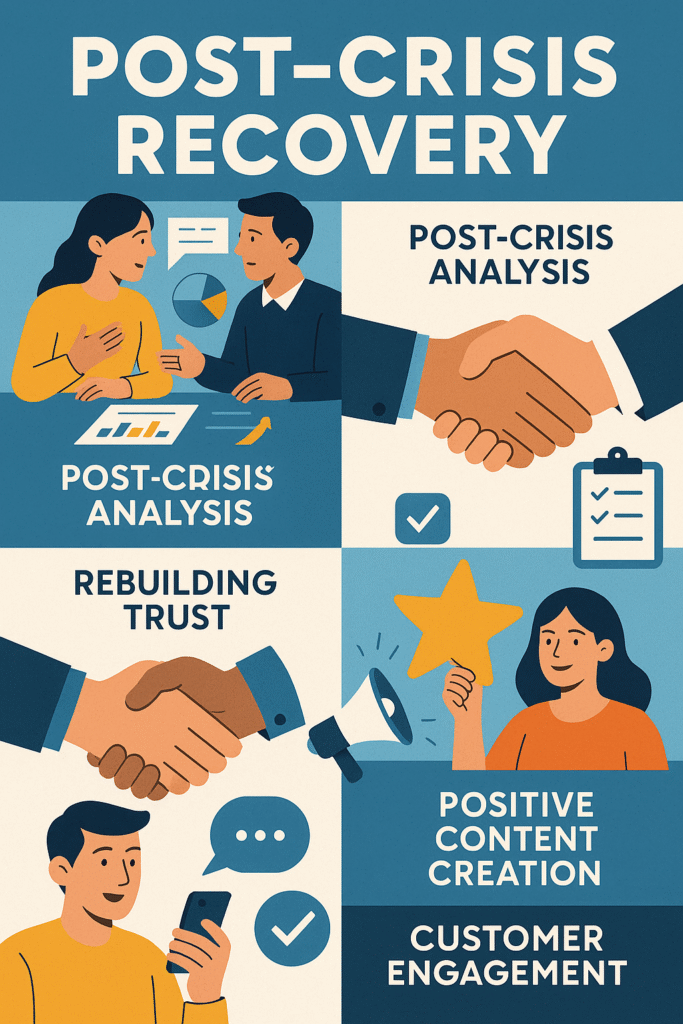
Post-Crisis Analysis and Learning
Post-crisis analysis helps companies learn from mistakes and improve future responses. Teams should review what worked well, what didn’t, and how processes can be enhanced. This analysis should include response times, message effectiveness, and customer feedback.
Rebuilding Trust
Rebuilding trust takes time and consistent action. Companies need to demonstrate lasting changes rather than just apologizing. This might involve policy updates, staff training, or system improvements that address root causes of problems.
Content Strategy During Recovery
Positive content creation helps shift focus away from negative incidents. Brand storytelling becomes crucial during recovery periods, highlighting company values and community contributions. This approach helps restore positive associations with the brand.
Sustained Customer Engagement
Customer engagement should continue after immediate crisis resolution. Ongoing communication shows that companies remain committed to addressing concerns and preventing future problems. This sustained effort often determines long-term reputation recovery success.
Technology Solutions for Crisis Prevention
AI-Powered Monitoring and Prediction
AI-powered monitoring tools can detect potential crises before they explode. These systems analyze conversation patterns, sentiment trends, and unusual activity spikes to identify problems early. Machine learning algorithms become more accurate over time, improving prediction capabilities.
Automated Response Systems
Automated response systems can handle routine issues while human teams focus on complex problems. Chatbots and auto-replies can acknowledge customer concerns immediately, providing basic information while escalating serious issues to human representatives.
Integrated Management Platforms
Social media management platforms integrate crisis management features with regular posting and engagement tools. This integration helps teams maintain normal operations while addressing crisis situations simultaneously.
Mobile Crisis Management
Mobile applications ensure that crisis management teams can respond from anywhere. Push notifications, mobile dashboards, and remote approval systems keep teams connected even outside business hours. This mobility is essential for 24/7 crisis response.
Best Practices for Social Media Crisis Communication
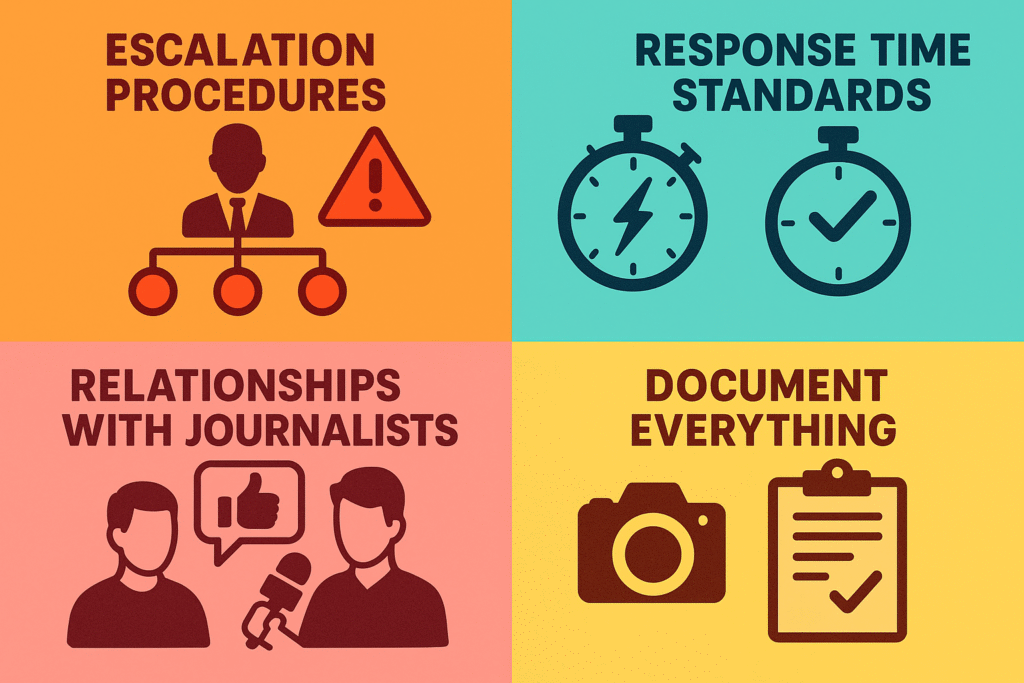
Establish clear escalation procedures that define when issues require executive involvement. Not every negative comment needs CEO attention, but serious crises demand leadership visibility. Having these thresholds defined prevents both overreaction and under-response.
Create response time standards for different types of situations. Simple customer service issues might need responses within an hour, while complex problems might require several hours for proper investigation. Setting expectations helps teams prioritize effectively.
Develop relationships with journalists and influencers before crises occur. These connections can provide valuable support during difficult times, offering platforms for explaining company positions and actions. Building authentic relationships makes crisis communication more effective.
Document everything during crisis situations. Screenshots, response times, and decision rationales create valuable records for post-crisis analysis. This documentation helps teams learn from experiences and improve future responses.
Advanced Crisis Management Techniques
Influencer partnerships can help amplify positive messages during recovery periods. Authentic endorsements from trusted voices often carry more weight than corporate communications. However, these relationships must be genuine rather than obvious paid promotions.
Content creation strategies should pivot during crisis situations. Regular marketing content might seem tone-deaf during serious problems, while educational or helpful content can demonstrate company values and expertise.
Cross-platform coordination ensures consistent messaging across all digital channels. Teams need protocols for updating websites, social media, email newsletters, and mobile apps simultaneously. Inconsistent information across platforms creates confusion and additional problems.
Legal considerations become crucial during serious crises. Response teams need clear guidelines about what can be said publicly, especially regarding ongoing investigations or potential litigation. Legal review processes should be streamlined to avoid dangerous delays.
Measuring Crisis Management Success
Response time metrics track how quickly teams identify and address problems. Faster response times generally correlate with better crisis outcomes. Companies should track both detection time and initial response time as key performance indicators.
Sentiment analysis tools measure how public opinion changes throughout crisis situations. Tracking sentiment trends helps teams understand whether their responses are effective or need adjustment. This data guides communication strategy modifications.
Engagement metrics reveal how audiences respond to crisis communications. High engagement with explanation posts might indicate effective messaging, while low engagement could suggest messages aren’t reaching intended audiences.
Long-term reputation tracking shows whether companies successfully recover from crisis situations. Brand mention sentiment, customer retention rates, and sales figures provide objective measures of recovery success over time.
Building Long-Term Crisis Strength
Regular training programs keep crisis management skills sharp across the organization. All employees should understand their roles during crisis situations, not just dedicated response teams. This organizational preparedness prevents small issues from becoming major problems.
Brand consistency in normal operations creates goodwill that helps during crisis situations. Companies with strong reputations often receive more patience and support when problems occur. This foundation makes crisis management more effective.
Customer relationship investment pays dividends during difficult times. Companies that regularly engage with customers, address concerns promptly, and demonstrate genuine care often find more support during crises. These relationships provide crucial context for crisis communications.
Technology infrastructure should be tested regularly to ensure it can handle crisis situations. Server capacity, backup systems, and communication tools need to function reliably during high-traffic periods. Technical failures during crises can amplify problems significantly.
Industry-Specific Crisis Management
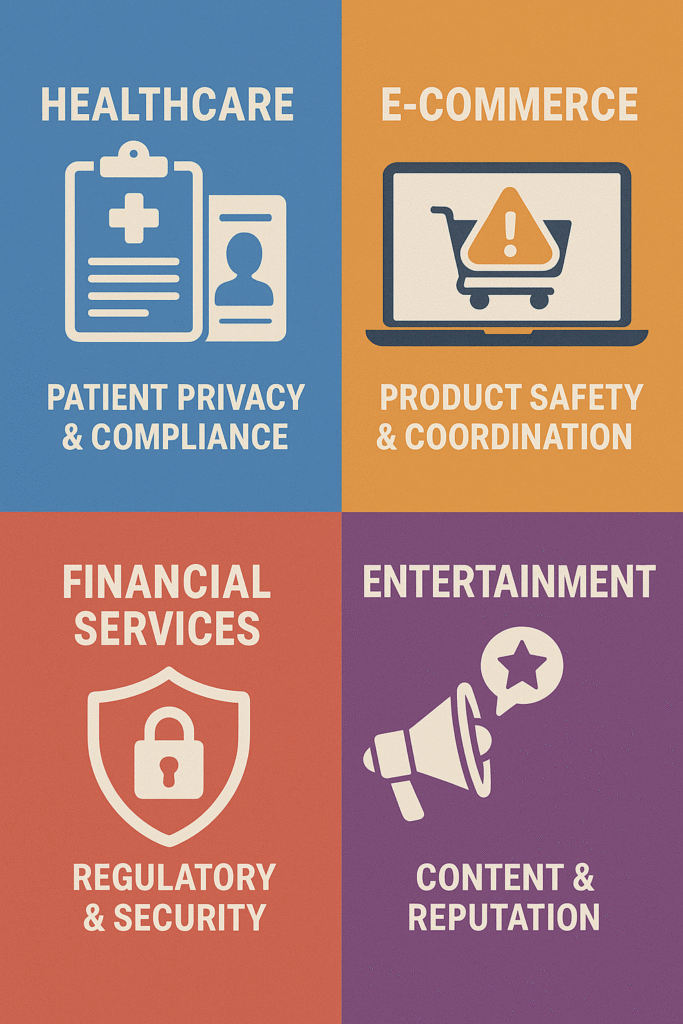
Healthcare organizations face unique challenges with patient privacy and regulatory compliance. Crisis communications must balance transparency with legal requirements. Professional communication standards become especially important in regulated industries.
E-commerce companies often deal with product-related crises that affect customer safety. These situations require coordination with legal teams, regulatory bodies, and supply chain partners. Response protocols must address both immediate safety concerns and long-term business impacts.
Financial services face strict regulatory requirements that affect crisis communications. Public statements about data breaches, service outages, or security issues must comply with specific notification requirements. These constraints require specialized response procedures.
Entertainment companies often deal with controversy-related crises involving personalities or content. These situations require careful balance between defending creative freedom and acknowledging legitimate concerns. Sound crisis management protects both artistic integrity and business interests.
Conclusion
Social media crisis management requires preparation, quick response, and authentic communication. Companies that invest in monitoring tools, train their teams, and develop clear protocols handle crises more effectively than those that react without preparation.
The key to successful crisis management lies in treating it as an ongoing process rather than a one-time event. Regular training, system updates, and relationship building create the foundation for effective crisis response. Companies that master these elements often emerge stronger from crisis situations.
Modern businesses cannot afford to ignore social media crisis management. The speed and reach of social platforms mean that small problems can quickly become major disasters. However, companies that respond authentically and transparently often find that crises become opportunities to demonstrate their values and build stronger customer relationships.
Start building your crisis management capabilities today. Implement monitoring systems, train your team, and develop response protocols before problems arise. The time spent on preparation will pay dividends when crisis situations inevitably occur.
Frequently Asked Questions
What is the most important factor in social media crisis management?
Speed of response is the most critical factor. Acknowledging problems quickly, even without complete solutions, prevents situations from escalating. Companies that respond within the first hour typically achieve better outcomes than those that delay.
How long should companies monitor social media for potential crises?
Social media monitoring should be continuous, operating 24/7. Crises don’t follow business hours, and problems that emerge overnight or during weekends can escalate quickly without proper monitoring. Automated systems can provide alerts during off-hours.
What’s the biggest mistake companies make during social media crises?
The biggest mistake is delaying response while trying to craft perfect messages. Perfect responses that come too late are less effective than imperfect responses that arrive quickly. Companies should acknowledge problems immediately and provide updates as more information becomes available.
How can small businesses afford crisis management tools?
Small businesses can start with free tools like Google Alerts and basic social media monitoring features. As budgets allow, they can upgrade to more sophisticated platforms. Many crisis management principles don’t require expensive tools – just good preparation and quick response capabilities.
Should companies delete negative comments during crises?
Generally, companies should not delete negative comments unless they violate platform policies or contain false information. Deleting legitimate criticism often makes situations worse by appearing to hide problems. Instead, companies should respond publicly and transparently to address concerns.
